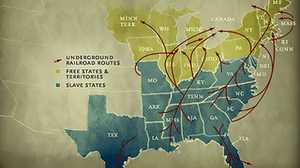The North and the Wage Slavery
Whether born slave or free, African Americans in the North found themselves at the center of the conflict over slavery. Read about three African Americans who became well-known for their involvement in the most important issue of their day.
Maria Stewart was America's first female African American political writer. Producing most of her work in the early 1830s, she preceded Sojourner Truth, Frances Harper, and even Frederick Douglass, who didn't launch his career until 1841. She was a pioneer of the abolition movement as well as of women's rights, the rights of African American women in particular. In 1832, 16 years ahead of the women's rights convention at Seneca Falls, Stewart publicly mounted a platform in Boston to give a political speech, the first time an American-born woman, African American or white, had done so. At that event she spoke out against the colonization movement, which sought to repatriate African Americans to Africa. In other speeches and essays, she called on African American women to develop their intellectual faculties and to destroy the racial and gender restrictions that bound them. An orphan by the age of five, she spent her early years as a household servant and experienced the hard toil many other Northern African Americans endured, in a status that Stewart considered to be only "nominally free." And yet she was heavily influenced by the dynamic African American community that surrounded her in Boston and the rapidly growing anti-slavery movement led by abolitionists David Walker and William Lloyd Garrison. During the Civil War, she was matron of a freedmen's hospital in Washington, D.C., and stayed there to teach and minister to the African American community until her death.
Shadrach Minkins was the first fugitive slave to be recaptured in New England under the Fugitibe Slave Law. A stricter enforcement of the law had been a provision of the Compromise of 1850 as a concession to Southern slaveholders. Boston possessed a small, free black population and was the nation's center of abolitionist activity, so it was naturally a prime target for slave catchers. Minkins was born a slave in Norfolk, Virginia (his birthdate has never been ascertained), and passed through several owners before coming to John DeBree, the man from whom Minkins would eventually escape. Minkins survived the perilous journey North to freedom and made it to Boston, where he was able to find work as a waiter in 1850. It was not long before DeBree presented proof of ownership to the Boston federal court, prompting federal officers to arrest Minkins while he was serving breakfast at the Cornhill Coffee House. He was taken to the courthouse, but at his trial, outraged black residents of the city, themselves threatened by the new Fugitive Slave Law, stormed into the courtroom and rescued him. The entire affair, from the arrest to the rescue, occurred over a period of only three hours. This time Minkins made the journey north to Quebec Province, where Canadian law guaranteed his freedom. There he married and raised a family, in a community largely made up of other fugitive slaves who had successfully sought freedom and a new life.
William Still was instrumental in Underground Railroad activity in Philadelphia. He was born free in 1821, the youngest of 18 children. At the age of 23, he arrived in Philadelphia and joined the Pennsylvania Society for Promoting the abolition of Slavery in 1847. While a member of the Society, Still would frequently board runaway slaves in his home until they were able to secure safe passage to Canada. By the time of the formation of the new Philadelphia Vigilance Committee, an agency of the Underground Railroad, Still was a prominent member of the African American community and was named its chairman. Among his duties were raising financial aid for the fugitives who came to the committee for help. This included paying for their room and board in free African Americans' homes, financing any medical aid that was needed, and purchasing railroad fares to Canada. But Still took greatest interest in recording the experiences of the 800-odd fugitives that his committee aided. Still documented details about the daily lives of the fugitives, including their time in slavery and their time in flight. In 1872, Still published this information in The Underground Rail Road, which circulated widely and went through three editions.
The wage Slavery
In the decade between 1846 and 1855, more than three million immigrants came to the United States, with a vast majority of them settling in the free states of the North. By 1855, foreign-born residents were becoming a majority group; immigrants approached or exceeeded half the total population of several Northern cities.
The new Americans arriving in this burst of immigration were nothing like those who had come before. Before 1840, three-quarters of all immigrants had been Protestants. Most were single men from the British Isles. Of those, a fifth became unskilled laborers or servants, and the remainder worked as farmers, skilled workers, or in professional occupations. But in the two decades after 1840, the typical immigrant's profile would radically change. More than half of all immigrants in these years were Catholics. Two-thirds were from Ireland, with the remainder from German-speaking countries. And the percentage of them who worked as unskilled laborers doubled.
The growing industrial economy of the North swallowed these new workers into its factories, employing them for long hours at low wages. These manufacturing jobs were repetitious and sometimes hazardous. And from their meager earnings, Northern laborers had to pay for every one of life's necessities.
For some Southerners, the situation of Northern workers looked a lot worse than slavery. In fact, they argued, unlike the "wage slavery" of the North, the slavery system in the South provided food, clothing, medical care, and leisure to slaves, caring for them throughout their lives. Prominent defenders of slavery, including George Fitzburgh, based their pro-slavery attitudes on a racist assessment of African Americans as inferior to whites.
On top of its fundamentally racist outlook, this Southern justification of slavery ignored the central issue of self-determination: Northern workers could make their own choices, leaving their jobs or possibly heading West to the frontier, while slaves could not.







